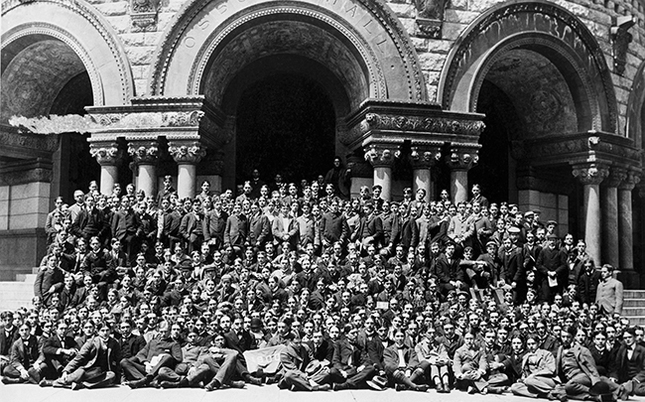
Bettmann
The Yale College Class of 1900 is shown here posing for a mass graduation photo in front of the (now demolished) Osborn Hall.
View full image

Bettmann
The Yale College Class of 1900 is shown here posing for a mass graduation photo in front of the (now demolished) Osborn Hall.
View full image
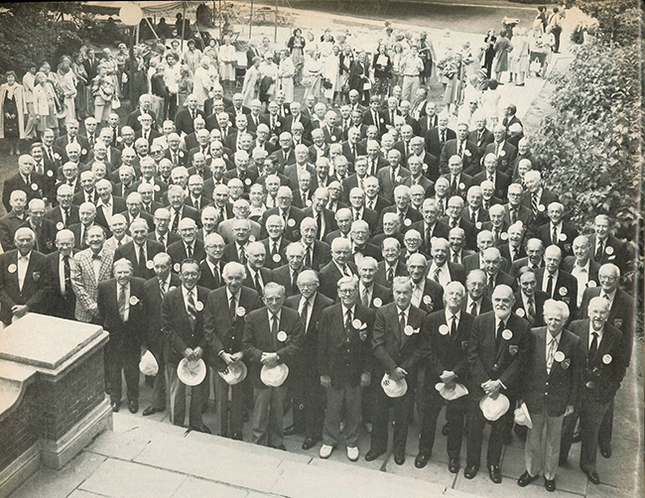
The Class of 1932 celebrates its fiftieth reunion.
View full image

The Class of 1932 celebrates its fiftieth reunion.
View full image
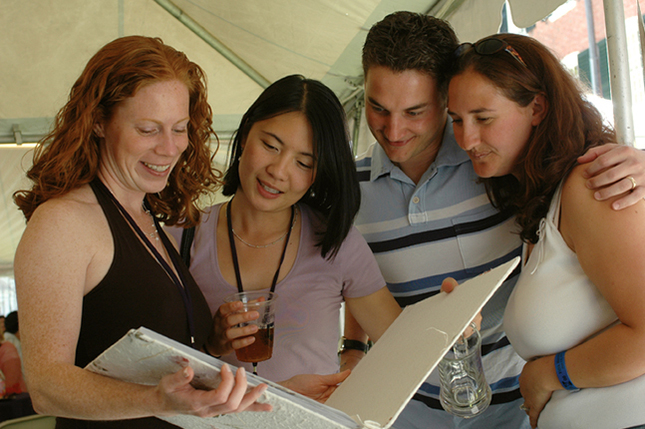
We don’t have the names of the people in this reunion photo and the following one. If you recognize anyone, drop a line to [email protected].
View full image

We don’t have the names of the people in this reunion photo and the following one. If you recognize anyone, drop a line to [email protected].
View full image
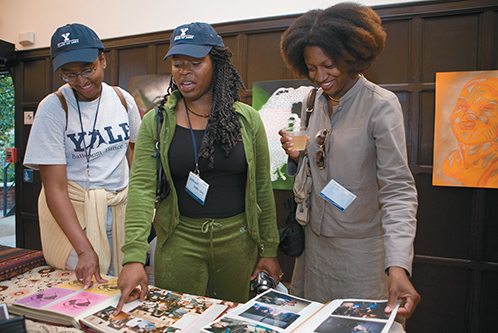

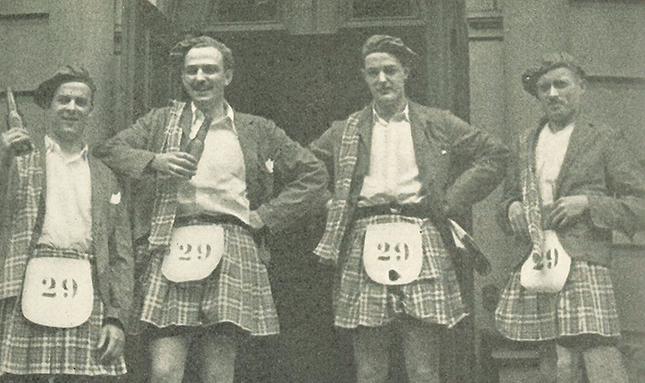
Decorative clothing or costumes were reunion specialties in earlier decades.
Members of the Class of 1929, dressed as Scotsmen.
View full image

Decorative clothing or costumes were reunion specialties in earlier decades.
Members of the Class of 1929, dressed as Scotsmen.
View full image
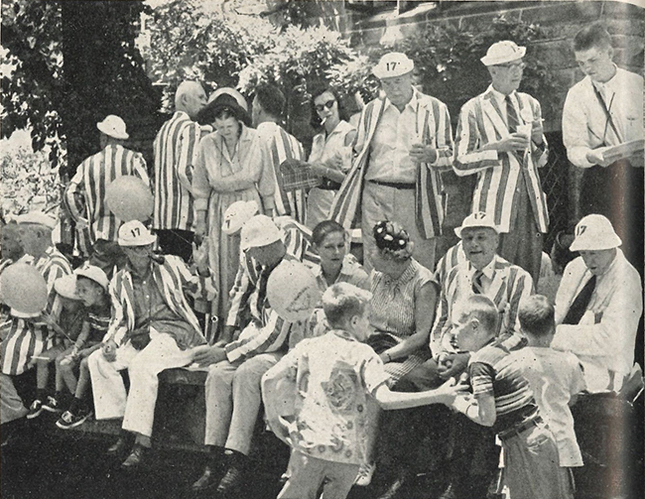
The Class of 1917 attended their fortieth reunion in blazers (no doubt striped Yale blue).
View full image

The Class of 1917 attended their fortieth reunion in blazers (no doubt striped Yale blue).
View full image
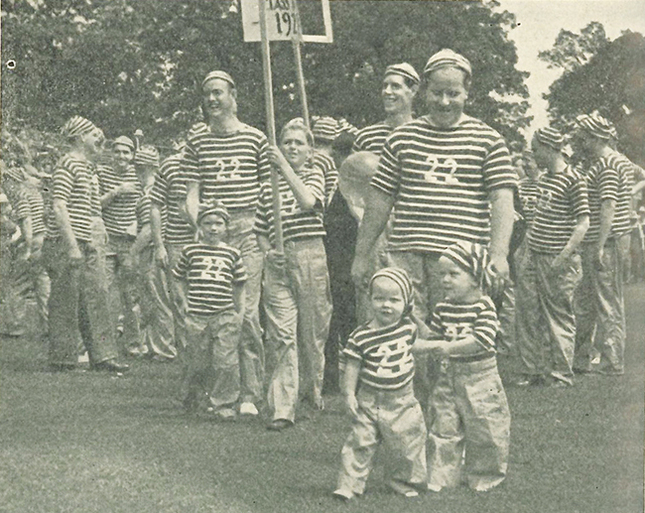
The Class of 1922 donned French sailor costumes for their tenth.
View full image

The Class of 1922 donned French sailor costumes for their tenth.
View full image
All of us recall the day we arrived on campus to be welcomed as the college’s newest undergraduates. We knew that our matriculation represented the opening of a new stage in our lives. But little did we then know that, over time, being a member of a particular class would become an identifier like our names, social security numbers, and nationalities—an invisible, unbidden denominator affixed to us forever. Nor, I’d guess, did any anticipate that our shared identity would become a way of locating ourselves in life as well as in time.
Although a few of us had known each other before matriculation, most were strangers to one another. We were simply adolescents of the same age, chosen for entrance by Yale’s admissions office and tossed together, like salad ingredients, to make a class. Our contrived kinship owed itself mostly to accident and coincidence. We were, as social theorists might say, a constructed community—one formed from outside, then left to be defined by its members’ acts and imaginings. Assembled to be a specific group, we were left to become that group on our own.
In recent years, I’ve become curious about what it means to be a college class and how its members experience the phases of its life. I’ve found myself asking these head-scratching questions because I serve as corresponding secretary of the Class of 1957. How, I’ve wondered, can an entity that neither reasons nor feels mean something to itself and be experienced by others? Perhaps it can’t. Yet don’t most of us, wherever we’ve been educated, reserve some place in our self-awareness, often in our affection, for what takes on embodiment in our minds as “our college class”?
And what about a class itself? It has some concreteness, doesn’t it? After all, some classes—those of Yale’s 1960 and 1964 come to mind—have been the subject of written histories. Most college graduates draw part of their identities from a sense that they belong to a specific unit of a larger, ever-changing institution, a unit that can claim a distinct history born of the era in which it took form. And many alumni have a sense that a class, mirroring changes in its members, itself changes over time—in fact as well as in mind.
Categorizing undergraduates by the date of their expected degrees commenced in Britain before taking hold at seventeenth- and eighteenth-century American colleges. But it was that hard-to-define adhesive known as class spirit that was needed before classes could begin to feel like distinct entities. That spirit took root in the United States from the fact that, until the introduction of elective courses after the Civil War, all members of the same college class (in the nineteenth century rarely larger than a hundred students) read the same books and studied the same prescribed subjects taught by the same teachers at the same time. Debating competitions, also prefigured at Oxford and Cambridge, provided another colonial-era bond as classmates vied against debaters from other classes. A less salutary British import—sophomore hazing of freshmen—was in the picture, too. Against harassment, protective intra-class solidarity became part of a class’s experience at the very start of its members’ college life.
In late colonial years, college officials, too, began to play a role in strengthening classes’ sense of identity. In the 1770s, for instance, the College of William and Mary instituted Class Day orations to accompany commencement exercises. By 1792, Yale allowed classes to choose their own officers. But gradually, class identity had to compete with a growing number of centripetal forces. Debating societies, sports teams, fraternities, and sororities—and at Yale, secret societies, campus organizations like the Glee Club and Whiffenpoofs, eventually residential colleges, and more recently identity-related affinity groups in a greatly diversified student body—raised obstacles to a sense of class cohesion. Also always working against the growth of solidarity was the emerging availability of elective courses. With the end of a unitary, lock-step curriculum and the gradual increase in the size of entering classes, what once could be personal familiarity between all members of a class slowly dissolved.
College and university administrators responded in part by turning to their institutions’ degree holders. Alumni associations came into existence. Prince-ton’s, founded in 1836, was among the earliest, its first president none other than James Madison. But that was not all. It didn’t take long for administrators to realize that class identity could help the larger institution gain financial support from its alumni and alumnae. At Yale, this led to the founding in 1890 of the Yale Alumni Fund and eventually to its practice of setting up competitions between alumni classes around their fundraising records.
What we take as the many other normal manifestations of class unity were mostly innovations of the twentieth century. Freshman registries, graduation books, class proms, commencement exercises and celebrations, alumni magazine columns, and—the strongest mortar—reunions, from which have arisen annual dinners, regional get-togethers, mini-reunions, group travel, websites, and recently virtual class gatherings: these have become what seem the natural fixatives of class cohesion.
Finally, no one can discount the role of campus events themselves in lending to each class, in memory as in fact, a sense of its particular history within the longer record of its embracing institution. In my years at Yale, 1954 saw the town-gown Snowball Riot and the debate between William F. Buckley Jr. ’50 and Vern Countryman over McCarthyism; 1955 brought an unexpected football victory over Army; a mass meeting in support of Hungarians’ anti-Soviet uprising took place in 1956; and in 1957 Billy Graham brought his ministry to campus—all, among other events, the binding, common experiences of a large proportion of us. We’re all legatees of these practices, rites, and occurrences, none of them foreordained, all of them lodged in the memories that lead to what constitutes the post-college life of each class.
What happens in that post-college life? How does a class experience itself over time? What are the stages of its maturity? After all, our college days are but the superstructure of our bonds. The rest must be built out after its members, each having experienced college years distinctively, scatter into the world like peace doves released to their freedom—off to forming families and building careers.
More than anything else, reunions are the institutionalized landmarks of this stage of class history. They express and sustain a class’s bonds, at least to those drawn to them. Their participants are witness to what’s happened since graduation. Of old friendships they’re restorative, of new ones generative. They’re the occasions when the intensified strength of class identity and adhesiveness is deeply felt. And they, like their participants, change.
The twenty-fifth reunion is the fulcrum on which a class’s post-commencement life turns. Its participants, many attending for the first time, become newly aware that they’re a quarter-century into their alumnihood. Competition—at least the comparison of how you’re doing in life compared with your classmates—is in the air; but so, too, is recognition of the class as a collective entity. Most classmates have grown up: the cutups appear more mature, the driven ones more relaxed, the uncompanionable more friendly. You’re surprised to find how the class stars appear normal, while those who previously weren’t so outstanding have grown to significant stature. You recognize yourself in the lives of others: their occupations, relationships, children. The class itself now claims your interest. Your affection for it grows.
And nostalgia: we’re linked not only through our undergraduate experiences but by what those “happy, golden, bygone days” come to mean to us afterward, at least to those for whom college years were a positive experience. Memory shapes us as much as do those years themselves. As students, we had at best a faint idea of where life might lead us. On campus, we started out linked by our designation as classmates; otherwise, because we were segregated across residential colleges, classrooms, clubs, and teams, we became acquainted with, and good friends of, only a fraction of our classmates.
It’s only after graduation and the slow shaping of memories of our college years that we begin to cohere, rather than just exist, as a class. From having been merely denominated as a class, we more fully recognize and think of ourselves as one. Our class begins to turn into a container for fellow feeling. The pull of an earlier identity begins to enlarge and fill in.
The fiftieth reunion is key. It’s when a class—a half-century on—begins to recognize that it has reached its full maturity. Many classes produce a major gift for their alma mater, a gift by which the class can live on in enduring institutional form. Memory and sentiment move to central place. And you become aware, as you may not have earlier, of the group’s mortality when the knell of deceased classmates’ names sounds from the pulpit of Battell Chapel.
I recall that memorial to lost classmates as the moment when the sense of collective identity captured everyone present. The class’s losses began to hit home. By then, you’d probably already lost a classmate dear to you. Even if you never knew many of the others, you’d heard their names, perhaps known what they had become and achieved since college days. No doubt some of them, like some of those still living, had never found their footings within the class and felt no class or institutional loyalty. Yet by then you experienced every deceased classmate as a diminishment. You’d internalized the collective reality of your class. Its future mortality was now bound up with yours.
When you approach your sixty-fifth reunion, as I’m approaching mine, you see and understand your class differently than you did when you left campus after accepting your bachelor’s degree. You’re in the final segment of your life. Your vision and plans have turned toward their close. Your college class seems to have become something manifest, not simply an emblem. Like you, it has had a life; like it and Yale itself, you are not what you used to be. News of the end of your classmates’ lives, rather than clouding their reality, seems to expand the class and your sense of what it and its members have signified to you. College days now seem a mere overture to what has followed; they’ve been joined in your mind by what your classmates have together become and collectively contributed to the world. You read your classmates’ obituaries not only startled by what some of them have accomplished but also with a sense, because of the decreasing numbers of your living classmates, of having lived a long life, now waning, coterminous with theirs.
So how, in the end, does one look at the extended existence of a college class? Will it pass and be forgotten with the rest? All of us will have our own answers to these questions. But surely its meaning is in part inherent in a class’s very existence, as well as in the record that its members leave behind. It may commence life adventitiously—having been conceived and birthed by strangers—but, like a lucky foundling, it finds nurturance in the embrace of its parental institution. And if all goes well, its members eventually find their bearings somewhere in the company of others claiming the same identity, then internalize their association with it as part of their own sense of self.
Toward its finale, to be the member of a class feels like a comradeship of shared identity, experiences, and lives. Just as it has helped define and possess you, you now possess your class as part of yourself. Your record is part of it just as its record is part of you. Perhaps that reciprocity is, above all, what it means to be a class.
 loading
loading